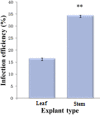Production of phenolic acids in hairy root cultures of medicinal plant Mentha spicata L. in response to elicitors
- PMID: 32582790
- PMCID: PMC7275824
- DOI: 10.22099/mbrc.2020.36031.1475
Production of phenolic acids in hairy root cultures of medicinal plant Mentha spicata L. in response to elicitors
Abstract
In this study, hairy root induction in leaf and stem explants of Mentha spicata using various Agrobacterium rhizogenes strains was established for the first time. Although inoculation of explants by immersion method resulted in tissue necrosis, direct injection of explants by all examined strains (A13,R318,A4,GMI 9534 and ATCC15834) was effective. All different parts of the stem were susceptible to A. rhizogenes infection. However, the middle and lower internodes showed a higher rate of transformation. Among the different strains, the strain A13 exhibited the highest infection efficiency (almost 75% of the explants). A13 and R318-infected hairy roots showed the highest biomass production (close to 60 mg/flask), while infection with GMI 9534 produced the highest content of phenolic acids. Finally, the effect of phytohormone elicitation on hairy root growth and phenolic acid biosynthesis was investigated. A substantial increase in root growth and phenolic acids accumulation was obtained followed by 0.3 mg L-1 IBA and 100 µM MeJA treatment, respectively.
Keywords: Agrobacterium rhizogenes; Hairy root; IBA; MeJA; Mentha spicata; Phenolic acids.
Figures





Similar articles
-
Influence of different Agrobacterium rhizogenes strains on hairy root induction and analysis of phenolic and flavonoid compounds in marshmallow (Althaea officinalis L.).3 Biotech. 2018 Aug;8(8):351. doi: 10.1007/s13205-018-1375-z. Epub 2018 Jul 31. 3 Biotech. 2018. PMID: 30073136 Free PMC article.
-
Effect of different Agrobacterium rhizogenes strains for in-vitro hairy root induction, total phenolic, flavonoids contents, antibacterial and antioxidant activity of (Cucumis anguria L.).Saudi J Biol Sci. 2020 Nov;27(11):2972-2979. doi: 10.1016/j.sjbs.2020.08.050. Epub 2020 Sep 6. Saudi J Biol Sci. 2020. PMID: 33100855 Free PMC article.
-
Elicitor-enhanced steroidal sapogenin accumulation in hairy root cultures of Trigonella foenum-graecum.Sci Rep. 2024 Aug 17;14(1):19106. doi: 10.1038/s41598-024-69625-8. Sci Rep. 2024. PMID: 39154043 Free PMC article.
-
Agrobacterium rhizogenes-mediated transformation: root cultures as a source of alkaloids.Planta Med. 2002 Oct;68(10):859-68. doi: 10.1055/s-2002-34924. Planta Med. 2002. PMID: 12391546 Review.
-
Harnessing the Potential of Roots of Traditional Power Plant: Ocimum.Front Plant Sci. 2021 Nov 1;12:765024. doi: 10.3389/fpls.2021.765024. eCollection 2021. Front Plant Sci. 2021. PMID: 34790216 Free PMC article. Review.
Cited by
-
Exogenous 24-epibrassinolide ameliorates tolerance to high-temperature by adjusting the biosynthesis of pigments, enzymatic, non-enzymatic antioxidants, and diosgenin content in fenugreek.Sci Rep. 2023 Apr 24;13(1):6661. doi: 10.1038/s41598-023-33913-6. Sci Rep. 2023. PMID: 37095206 Free PMC article.
-
Accumulation of phenolic compounds and expression of phenylpropanoid biosynthesis-related genes in leaves of basil transformed with A. rhizogenes strains.Physiol Mol Biol Plants. 2023 May;29(5):629-640. doi: 10.1007/s12298-023-01320-w. Epub 2023 Jun 9. Physiol Mol Biol Plants. 2023. PMID: 37363423 Free PMC article.
-
The combination of R2R3-MYB gene AmRosea1 and hairy root culture is a useful tool for rapidly induction and production of anthocyanins in Antirrhinum majus L.AMB Express. 2021 Sep 14;11(1):128. doi: 10.1186/s13568-021-01286-6. AMB Express. 2021. PMID: 34519881 Free PMC article.
-
Production of secondary metabolites using tissue culture-based biotechnological applications.Front Plant Sci. 2023 Jun 29;14:1132555. doi: 10.3389/fpls.2023.1132555. eCollection 2023. Front Plant Sci. 2023. PMID: 37457343 Free PMC article. Review.
-
A Comprehensive Review of the Key Characteristics of the Genus Mentha, Natural Compounds and Biotechnological Approaches for the Production of Secondary Metabolites.Iran J Biotechnol. 2023 Oct 1;21(4):e3605. doi: 10.30498/ijb.2023.380485.3605. eCollection 2023 Oct. Iran J Biotechnol. 2023. PMID: 38269203 Free PMC article. Review.
References
-
- Ziaková A, Brandšteterová E. Validation of HPLC determination of phenolic acids present in some lamiaceae family plants. J Liq Chromatogr Relat Technol. 2003;26:443–453.
-
- Ghasemzadeh A, Ghasemzadeh N. Flavonoids and phenolic acids: Role and biochemical activity in plants and human. J Med Plant Res. 2011;5:6697–6703.
-
- Hao G, Jiang X, Feng L, Tao R, Li Y, Huang L. Cloning, molecular characterization and functional analysis of a putative R2R3-MYB transcription factor of the phenolic acid biosynthetic pathway in S miltiorrhiza Bge f alba. Plant CellTiss Org Cult2016. 124:151–168.
-
- Zhang S, Yan Y, Wang B, Liang Z, Liu Y, Liu F, Qi Z. Selective responses of enzymes in the two parallel pathways of rosmarinic acid biosynthetic pathway to elicitors in Salvia miltiorrhiza hairy root cultures. J Biosci Bioeng. 2014;117:645–651. - PubMed
-
- Petersen M, Simmonds MSJ. Rosmarinic acid. Phytochemistry. 2003;62:121–125. - PubMed
LinkOut - more resources
Full Text Sources
Molecular Biology Databases
